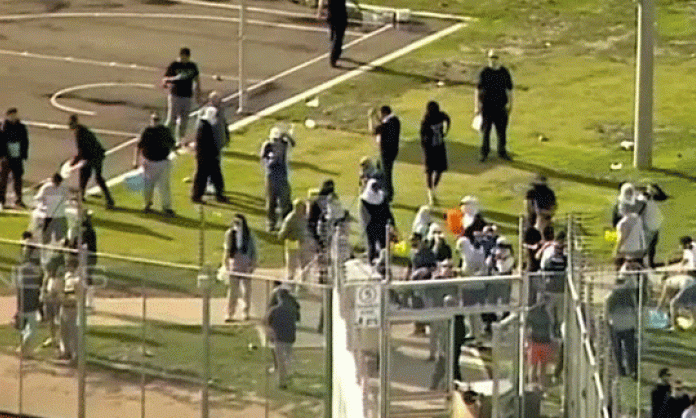The 30 June riot at Melbourne’s Metropolitan Remand Centre in Ravenhall has brought an avalanche of tut-tutting, and stern calls for criminal charges to be laid against the 300 participants.
Breathless reporters have parroted the allegation that the inmates include “murderers and rapists” alongside the bogeyman-of-the-hour, the omnipresent “bikie gang leader”, all apparently on the verge of mass homicide after having their smokes taken away.
We should hardly have to point this out, but in a remand centre, the majority of inmates are still awaiting the outcome of their trials. They’ve not necessarily been found guilty of anything, and yet can be held indefinitely. Even Corrections Victoria, the government department in charge of the prison system, admits:
“Remandees are unsentenced and are innocent until proven guilty. The law does not regard their confinement as punishment.”
More to the point, there is something profoundly inhuman in the argument that being found guilty of a crime removes every last iota of your right to personal freedom – right down to having a smoke.
Such views traditionally have been isolated to the most reactionary of political commentators, the sorts who believe in corporal punishment and hard labour. Now it seems disturbingly mainstream, and a predictable outcome of relentless law-and-order campaigning by successive Victorian governments.
Since the riot, many reports have misrepresented the nature of the smoking ban. They paint a picture of smoke-filled slammers where frightened prison guards cough-and-splutter their way through each shift surrounded by ne’er-do-wells with nothing but murder on their minds.
In fact, smoking inside Victorian prison buildings has been banned for years; inmates are liable for a summary $10 fine for any breach. The point of the new ban is to stop inmates smoking outside in formerly designated smoking areas.
It’s abundantly clear that the whole exercise has nothing to do with the health concerns of inmates, nor with protecting prison staff from second-hand smoke (despite the claims of the guard’s union).
Rather, it’s about increasing control over every instance of freedom, every second of an inmate’s day, every possible avenue through which they might have a say over their own body.
The whole thing is like some kind of cruel laboratory experiment on caged human subjects, prompting all sorts of sickening comments on Melbourne radio. Even before the riot, the general consensus was that “these people” had forfeited their right to complain about any manner of ill-treatment.
I say good on the inmates for asserting themselves. They’ve demonstrated an eternal truth, that people’s humanity is expressed in resistance. This is particularly true in the prison system – history shows that riots and mass resistance are the only way conditions improve.
In 1991, Western Australia’s notorious Fremantle prison was closed following a government inquiry into the facility’s conditions and administration.
The McGivern Inquiry reported severe overcrowding. Inmates were held in tiny unsewered cells infested with cockroaches and mice, in which people were “compelled to eat, sleep and defecate”.
Inmates reported constant abuse from guards, deliberate provocations, and a systemic refusal from prison administration to comply with their own policies and procedures – particularly when it came to processing prisoner complaints or requests.
The report’s finding didn’t come as a shock to anyone. Three years earlier the inmates had risen up in a 19-hour riot to demand improvements. The Inquiry was a response to the riot – if there’d been no riot, there would have been no Inquiry, and for all we know Fremantle Prison would be operating to this day.
Moreover, in the 15 years leading up to the riot there was a series of sit-ins and protests, driving home the message that the inmates would break Fremantle prison before it broke them.
And it’s not as though the WA authorities were ignorant of the situation inside. It has been standard practice to make prisons hell holes.
Conditions in Fremantle Gaol had first been investigated in the Jameson Royal Commission way back in 1898. It found that the prison was “in no way structurally adapted to meet the varied purposes which it is now required to serve”. The report detailed sickening abuses, chronic overcrowding, a total lack of sanitary infrastructure and poor ventilation.
But the Jameson findings are significant not just because of the appalling conditions described, and not even because the McGivern Inquiry 90 years later found little had improved.
Jameson also made some strident political arguments as to the essential purpose of imprisonment, which explain the cruel logic of places like the Melbourne Remand Centre today. He explained that the aim is not “to make the prison a comfortable home for the depraved [sic] members of society”.
On the contrary, Jameson identified potential benefits in worsening the conditions for inmates, recommending “prison life, consistent with the requirements of ordinary humanity and justice, be made as uncomfortable to the prisoner as possible”.
Jameson never thought to call for a ban on smoking. But then he didn’t have a mountain of scientific evidence in which to cloak such trivial cruelty.
A century later, with prison populations across Australia reaching record numbers, and with more money now being spent on prisons than on public housing, it’s clear that the state has only hardened in its stance.
Prisons, full of people whose only crime often is being either poor or Aboriginal, or both, is to be made all the more punitive.









